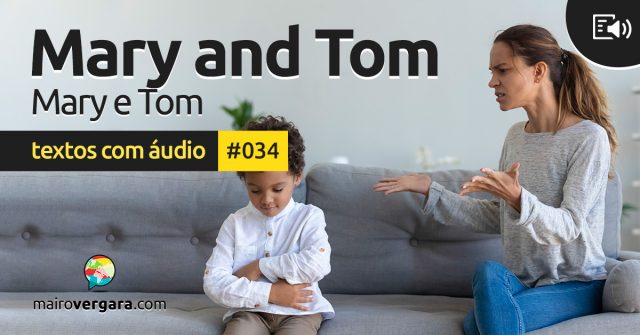ÁUDIO DO TEXTO
TEXTO EM COLUNAS
| Mary and Tom | Mary e Tom (tradução) |
| Mary is mad at her son Tom. He is not doing the dishes, and he is not cleaning his room. He is not studying either, and the teachers say he is not paying attention in class. Right now, he is watching TV. Mary is saying: “Study, please, you have a test tomorrow!”, but he is not listening. He is not thinking about his future! But Mary is not giving up. Look: she is turning off the TV! | A Mary está brava com seu filho Tom. Ele não está lavando a louça e não está limpando seu quarto. Ele também não está estudando, e os professores dizem que ele não está prestando atenção na aula. Neste momento, ele está assistindo a televisão. Mary está dizendo: “Estude, por favor, você tem uma prova amanhã!”, mas ele não está escutando. Ele não está pensando no seu futuro! Mas Mary não vai desistir. Veja: ela está desligando a televisão! |
TEXTO LINHA A LINHA
Mary is mad at her son Tom.
Mary está zangada com seu filho Tom.
Nota: é importante sempre prestarmos atenção no contexto e nas combinações de palavras. Mad pode ter o sentido de louca/louco. Mas quando alguém está mad at alguma pessoa, quer dizer que está zangado/zangada: I’m mad at him = Estou zangada com ele. Além disso, se alguém é mad about alguma pessoa, quer dizer que está apaixonado/apaixonada: I’m mad about him = Sou louca (apaixonada) por ele.
He is not doing the dishes,
Ele não está lavando a louça,
Nota: do the dishes (literalmente: fazer a louça) tem o sentido de lavar a louça.
and he is not cleaning his room.
e ele não está limpando seu quarto.
He is not studying either,
Ele também não está estudando,
Nota: lembrando que either tem o sentido de também em frases negativas.
and the teachers say he is not paying attention in class.
e os professores dizem que ele não está prestando atenção na aula.
Right now, he is watching TV.
Neste momento, ele está assistindo a TV.
Mary is saying:
Mary está dizendo:
“Study, please, you have a test tomorrow!”,
“Estude, por favor, você tem uma prova amanhã”!
but he is not listening.
mas ele não está ouvindo.
He is not thinking about his future!
Ele não está pensando em seu futuro!
But Mary is not giving up.
Mas Mary não está desistindo.
Nota: give up é um phrasal verb e um de seus sentidos é desistir.
Look: she is turning off the TV!
Olhem: ela está desligando a TV!
Nota:turn off é um phrasal verb e um de seus sentidos é desligar.
FOCO DO TEXTO
O foco do texto são as estruturas:
SHE IS NOT + VERBO COM ING e
HE IS NOT + VERBO COM ING.
NOTAS EXPANDIDAS
1 – Para dizer que ele ou ela não está fazendo alguma coisa, usamos a estrutura HE/SHE IS NOT + VERBO COM ING (lembrando que no lugar de HE ou SHE podemos ter um nome ou uma expressão do tipo my brother, my friend etc.):
| He is studying. | Ele está estudando. |
| He is not studying. | Ele não está estudando. |
| She is working. | Ela está trabalhando. |
| She is not working. | Ela não está trabalhando. |
| My brother is playing the piano. | Meu irmão está tocando piano. |
| My brother is not playing the piano. | Meu irmão não está tocando piano. |
| Anna is sleeping. | A Anna está dormindo. |
| Anna is not sleeping. | A Anna não está dormindo. |
| Her father is driving. | O pai dela está dirigindo. |
| Her father is not driving. | O pai dela não está dirigindo. |
| Peter is doing the dishes. | O Peter está lavando a louça. |
| Peter is not doing the dishes. | O Peter não está lavando a louça. |
2 – Phrasal verbs são verbos formados por duas ou mais partes – geralmente um verbo e uma preposição – com um sentido específico, que pode ser totalmente diferente do sentido do verbo sozinho. Vamos ver mais exemplos com os dois phrasal verbs que aparecem no texto:
Give up – desistir
| I give up; just tell me the answer. | Eu desisto; apenas me diga a resposta. |
| I promise I won’t give up! | Eu prometo que não vou desistir! |
| You shouldn’t give up. | Você não deveria desistir. |
| She doesn’t give up easily. | Ela não desiste facilmente. |
Turn off – desligar
| Please, turn off the TV. | Por favor, desligue a TV. |
| Don’t forget to turn off the lights. | Não se esqueça de deslizar as luzes. |
| Remember to turn off the gas. | Lembre-se de desligar o gás. |
| How do I turn off the alarm? | Como eu desligo o alarme? |
TEXTO COM CONTRAÇÕES
Contrações são muito comuns no inglês falado e na linguagem escrita informal. Geralmente são marcadas pelo apóstrofo (’). Vamos apresentar duas formas possíveis de se usar contrações neste texto. Notem que o sentido não muda.
Contrações utilizadas neste texto:
Mary’s = Mary is
He’s not = He is not
She’s not = She is not
She’s = she is
ÁUDIO DO TEXTO 01
TEXTO EM COLUNAS 01
| Mary and Tom – with contractions 01 | Mary and Tom – com contrações 01 (tradução) |
| Mary’s mad at her son Tom. He’s not doing the dishes, and he’s not cleaning his room. He’s not studying either, and the teachers say he’s not paying attention in class. Right now, he’s watching TV. Mary’s saying: “Study, please, you have a test tomorrow!”, but he’s not listening. He’s not thinking about his future! But Mary’s not giving up. Look: she’s turning off the TV! | A Mary está brava com seu filho Tom. Ele não está lavando a louça e não está limpando seu quarto. Ele também não está estudando, e os professores dizem que ele não está prestando atenção na aula. Neste momento, ele está assistindo a televisão. Mary está dizendo: “Estude, por favor, você tem uma prova amanhã!”, mas ele não está escutando. Ele não está pensando no seu futuro! Mas Mary não vai desistir. Veja: ela está desligando a televisão! |
Contrações utilizadas neste texto:
Mary’s = Mary is
He isn’t = He is not
Mary isn’t = Mary is not
She’s = She is
ÁUDIO DO TEXTO 02
TEXTO EM COLUNAS 02
| Mary and Tom – with contractions 02 | Mary and Tom – com contrações 02 (tradução) |
| Mary’s mad at her son Tom. He isn’t doing the dishes, and he isn’t cleaning his room. He isn’t studying, either, and the teachers say he isn’t paying attention in class. Right now, he’s watching TV. Mary’s saying: “Study, please, you have a test tomorrow!”, but he isn’t listening. He isn’t thinking about his future! But Mary isn’t giving up. Look: she’s turning off the TV! | A Mary está brava com seu filho Tom. Ele não está lavando a louça e não está limpando seu quarto. Ele também não está estudando, e os professores dizem que ele não está prestando atenção na aula. Neste momento, ele está assistindo a televisão. Mary está dizendo: “Estude, por favor, você tem uma prova amanhã!”, mas ele não está escutando. Ele não está pensando no seu futuro! Mas Mary não vai desistir. Veja: ela está desligando a televisão! |


















